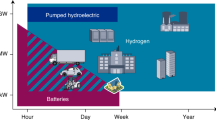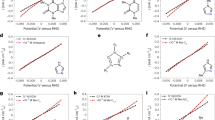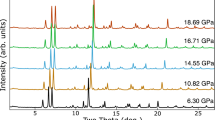Abstract
Palladium and palladium alloys are quite widely used as membranes for hydrogen permeation, because of their resistance to embrittlement and to irreversible deformations during cycles of absorption and desorption of hydrogen1–3. The isothermal relationships between hydrogen diffusion coefficient, DH, and hydrogen content, n (ratio of hydrogen/metal atoms) has both technological and academic interest. The most detailed form of relationships2,3 between DH and n have been those reported for deuterium in Pd75Ag25 by Hickman4 within the temperature range 300–500°C, and for protium in Pd7Ag23 within the range 30–75°C by Küssner5. For increasing values of n up to n ∼ 0.2, Küssner5 reported significant corresponding decreases of DH (by a factor of ∼ 8 from n=0 up to n ∼ 0.16 at 30°C). This is the reverse of trends in the values of DH with increasing n suggested by measurements of anelastic effects3,6,7 and also by the permeation rate measurements of Hickman4 at 300 and 400°C. Here we report measurements of diffusion through Pd81Pt19 alloy, the results of which are consistent with Gorskii's hypothesis relating long-range anelastic diffusion of lattice interstitials to elastic strain gradients.
This is a preview of subscription content, access via your institution
Access options
Subscribe to this journal
Receive 51 print issues and online access
$199.00 per year
only $3.90 per issue
Buy this article
- Purchase on Springer Link
- Instant access to full article PDF
Prices may be subject to local taxes which are calculated during checkout
Similar content being viewed by others
References
Lewis, F. A. The Palladium-Hydrogen System (Academic, London and New York, 1967).
Wicke, E., Brodowsky, H. & Züchner, H. Topics appl. Phys. 29, 73 (1978).
Lewis, F. A. Platinum Metals Rev. 26, 20, 70, 121 (1982).
Hickman, R. G. J. Less-Common Metals 19, 369 (1969).
Küssner, A. Z. Naturforsch. 21 a, 515 (1966).
Mazzolai, F. M., Nuovo, M. & Lewis, F. A. Scripta metall. 9, 617 (1975).
Nuovo, M., Mazzolai, F. M. & Lewis, F. A. J. Less-Common Metals 49, 37 (1976).
Boes, N. & Züchner, H. J. Less-Common Metals 49, 233 (1976).
Maestes, S. & Flanagan, T. B. J. phys. Chem. 77, 850 (1973).
Schaumann, G., Völkl, J. & Alefeld, G. Phys. Rev. Lett. 21, 891 (1968).
Cantelli, R., Mazzolai, F. M. & Nuovo, M. Phys. Status Solidi 34, 397 (1969).
de Ribaupierre, Y. & Manchester, F. D. J. Phys. C7, 2126 (1974).
Völkl, J. & Alefeld, G. Z. phys. Chem. neue Folge 114, 129 (1979).
Mazzolai, F. M. & Züchner, H. Z. phys. Chem. neue Folge 124, 59 (1981).
C̄ermák, J. & Kufudakis, A. J. Less-Common Metals 49, 309 (1976).
Kufadakis, A., Čermák, J. & Lewis, F. A. Surf. Technol. 16, 57 (1982).
Gorskii, V. S. Phys. Z. SowjU. 8, 457 (1935).
Wipf, H. J. Less-Common Metals 49, 291 (1976).
Carson, A. W., Flanagan, T. B. & Lewis, F. A. Nature 183, 39–510 (1959).
Baranowski, B., Lewis, F. A., McFall, W. D., Filipek, S. & Witherspoon, T. C. Proc. R. Soc. A386, 309 (1983).
Brodowsky, H. & Poeschel, E. Z. phys. Chem. neue Folge 44, 143 (1965).
Carson, A. W. & Lewis, F. A. Trans. Faraday Soc. 63, 1453 (1967).
Lewis, F. A., Johnston, R. C., Witherspoon, M. C. & Obermann, A., Surf. Technol. 18, 147 (1983).
Lewis, F. A., Hull, M. N., Johnston, R. C. & Witherspoon, M. C. Surf. Technol. 18, 167 (1983).
Baranowski, B., Majchrzak, S. & Flanagan, T. B. J. Phys. F1, 258 (1971).
Alefeld, G. Phys. Status Solidi 32, 67 (1969).
Manchester, F. D. J. Less-Common Metals 49, 1 (1976).
Bond, R. A. & Ross, D. K. J. Phys. F12, 597 (1982).
see e.g., Burch, R. & Lewis, F. A. A. Rep. chem. Soc. 67, 231 (1970).
Petropoulos, J. H. & Roussis, P. P. J. chem. Phys. 47, 1491, 1496 (1967); 48, 4629 (1968); 50, 3951 (1969).
Čermák, J. Roczn. Chem. 50, 1741 (1975).
Author information
Authors and Affiliations
Rights and permissions
About this article
Cite this article
Lewis, F., Magennis, J., McKee, S. et al. Hydrogen chemical potentials and diffusion coefficients in hydrogen diffusion membranes. Nature 306, 673–675 (1983). https://doi.org/10.1038/306673a0
Received:
Accepted:
Issue Date:
DOI: https://doi.org/10.1038/306673a0
This article is cited by
-
Thermodynamic properties of silver–palladium alloys determined by a solid state electrochemical method
Journal of Materials Science (2014)
Comments
By submitting a comment you agree to abide by our Terms and Community Guidelines. If you find something abusive or that does not comply with our terms or guidelines please flag it as inappropriate.



